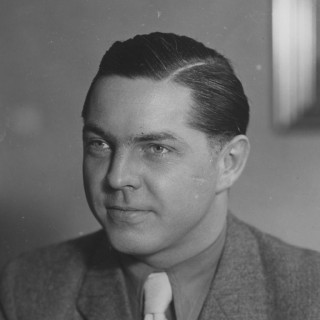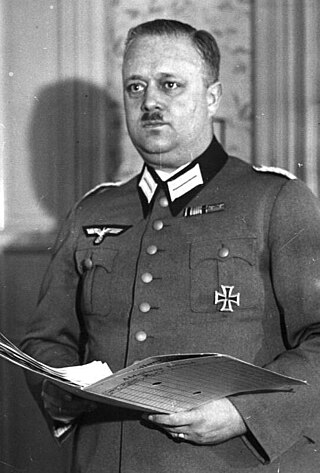
Alfred-Maurice de Zayas is a Cuban-born American lawyer and writer, active in the field of human rights and international law. From 1 May 2012 to 30 April 2018, he served as the first UN Independent Expert on the Promotion of a Democratic and Equitable International Order, appointed by the United Nations Human Rights Council.
The 10th Infantry Division was created in October 1934 under the cover name Wehrgauleitung Regensburg to hide its violation of the Treaty of Versailles. It was renamed the 10th Infantry Division when the establishment of the Wehrmacht was announced publicly in October 1935.

The German 20th Infantry Division was an infantry division of Nazi Germany.

The 3rd Infantry Division was an infantry division of the German Army that fought in World War II. The division was established under the cover name Wehrgauleitung Frankfurt in 1934 by expanding the 3rd Division of the Reichswehr. It was redesignated Kommandant von Frankfurt shortly afterward, and took on its bona fide name when the formation of the Wehrmacht was announced in October 1935. In March 1939 the division took part in the invasion and occupation of Czechoslovakia.

Johannes Frießner was a German general in the Wehrmacht during World War II. He was a recipient of the Knight's Cross of the Iron Cross with Oak Leaves.

Louis Rudolph Franz Schlegelberger was State Secretary in the German Reich Ministry of Justice (RMJ) who served as Justice Minister during the Third Reich. He was the highest-ranking defendant at the Judges' Trial in Nuremberg.

Fritz Hippler was a German filmmaker who ran the film department in the Propaganda Ministry of Nazi Germany, under Joseph Goebbels. He is best known as the director of the propaganda film Der Ewige Jude .
Erich Dethleffsen was a German general from Kiel. He was married to the daughter of Nikolaus von Falkenhorst, who planned the German invasion of Norway and Denmark during World War II.
Heidegger Gesamtausgabe is the title of the collected writings of German philosopher Martin Heidegger (1889-1976), published by Vittorio Klostermann.

The Wehrmacht War Crimes Bureau, 1939–1945 is a book by Alfred-Maurice de Zayas. It was published in November 1979 in Germany by Universitas/Langen Müller under the title Die Wehrmacht-Untersuchungsstelle, and in America in 1989 under the title The Wehrmacht War Crimes Bureau, 1939-1945 by the University of Nebraska Press. Professor Howard S. Levie, an expert in international humanitarian law, provided the preface for the American version. The book describes some of the work of the Wehrmacht War Crimes Bureau, a special section of the legal department of the Wehrmacht High Command, which collected reports of alleged Allied and German war crimes for purposes of diplomatic protests, war crimes trials, and white books.
Hans-Hellmuth Pfeifer was a German general during World War II. A veteran of World War I, he held higher command positions in WWII, among other, that of the 65th Infantry Division in Italy, selecting its hand grenade symbol which earned the nickname "The Hand Grenade Division."
Johann Paul Friedrich Drekmann was a German officer, a Diplom-Ingenieur and a highly decorated Generalleutnant in the Wehrmacht during World War II. He was also a recipient of the Knight's Cross of the Iron Cross. The Knight's Cross of the Iron Cross was awarded to recognise extreme battlefield bravery or successful military leadership. Paul Drekmann was captured by British troops in May 1945 and was held until 1947.

Jan Philipp Fürchtegott Reemtsma is a German literary scholar, author, and patron who founded and was the long-term director of the Hamburg Institute for Social Research. Reemtsma lives and works mainly in Hamburg.

Hasso von Wedel was a German general who commanded the Wehrmacht Propaganda Troops during World War II. He was directly subordinate to the head of OKW Operations Staff, General Alfred Jodl. Wedel's Propaganda Department had control over the propaganda units and served to mediate between them and the Reich Propaganda Ministry of Joseph Goebbels.
The massacre of Grischino was committed by the Red Army in February 1943 in the eastern Ukrainian town of Krasnoarmeyskoye, earlier named Postyschevo and Grischino. The massacre followed the capture of the town by the advancing Soviet army. A total of 596 prisoners of war, nurses, construction workers and female communication personnel (Nachrichtenhelferinnen) were killed. The Wehrmacht Untersuchungsstelle also known as WuSt, announced that among the victims were 406 soldiers of the Wehrmacht, 58 members of the Organisation Todt, 89 Italian soldiers, nine Romanian soldiers, four Hungarian soldiers, 15 German civil officials, seven German civilian workers and eight Ukrainian collaborators.
The Massacre of Broniki referred to the killing of members of the Wehrmacht by soldiers of the Red Army, on 1 July 1941 near the place Broniki, Rivne Raion in western Ukraine. Of the 153 victims from Infantry Regiment 35 who were found, 132 "have been slaughtered in a bestial manner and were mutilated," as later the division commander of the 25th Infantry Division (mot.) reported.
A war of annihilation or war of extermination is a type of war in which the goal is the complete annihilation of a state, a people or an ethnic minority through genocide or through the destruction of their livelihood. The goal can be outward-directed or inward, against elements of one's own population. The goal is not like other types of warfare, the recognition of limited political goals, such as recognition of a legal status, control of disputed territory, or the total military defeat of an enemy state.
Hans Heinrich Eggebrecht was a German musicologist and professor of historical musicology at the Albert-Ludwigs-Universität in Freiburg.
Helmuth Osthoff was a German musicologist and composer. Much of his career was spent at Frankfurt University, prior to which he held posts at Halle University and Berlin University. He wrote the first major biography on the composer Josquin des Prez, published as a two volume monograph in 1962 and 1965
The 225th Infantry Division was an infantry division of the German Heer during World War II.









